module 12 Terrestrial Biomes
Climate affects the distribution of species around the globe. For example, only species that are well adapted to hot and dry conditions can survive in deserts. A very different set of organisms survives in cold, snowy places. In this module, we will examine how differences in climate help determine the species of plants and animals that live in each region and how scientists categorize these regions.
Learning Objectives
After reading this module you should be able to
explain how we define terrestrial biomes.
interpret climate diagrams.
identify the nine terrestrial biomes.
Terrestrial biomes are defined by the dominant plant growth forms
Scientists have long recognized that organisms possess distinct growth forms, many of which represent adaptations to local temperature and precipitation patterns. For example, if we were to examine the plants from all the deserts of the world, we would find many cactus-
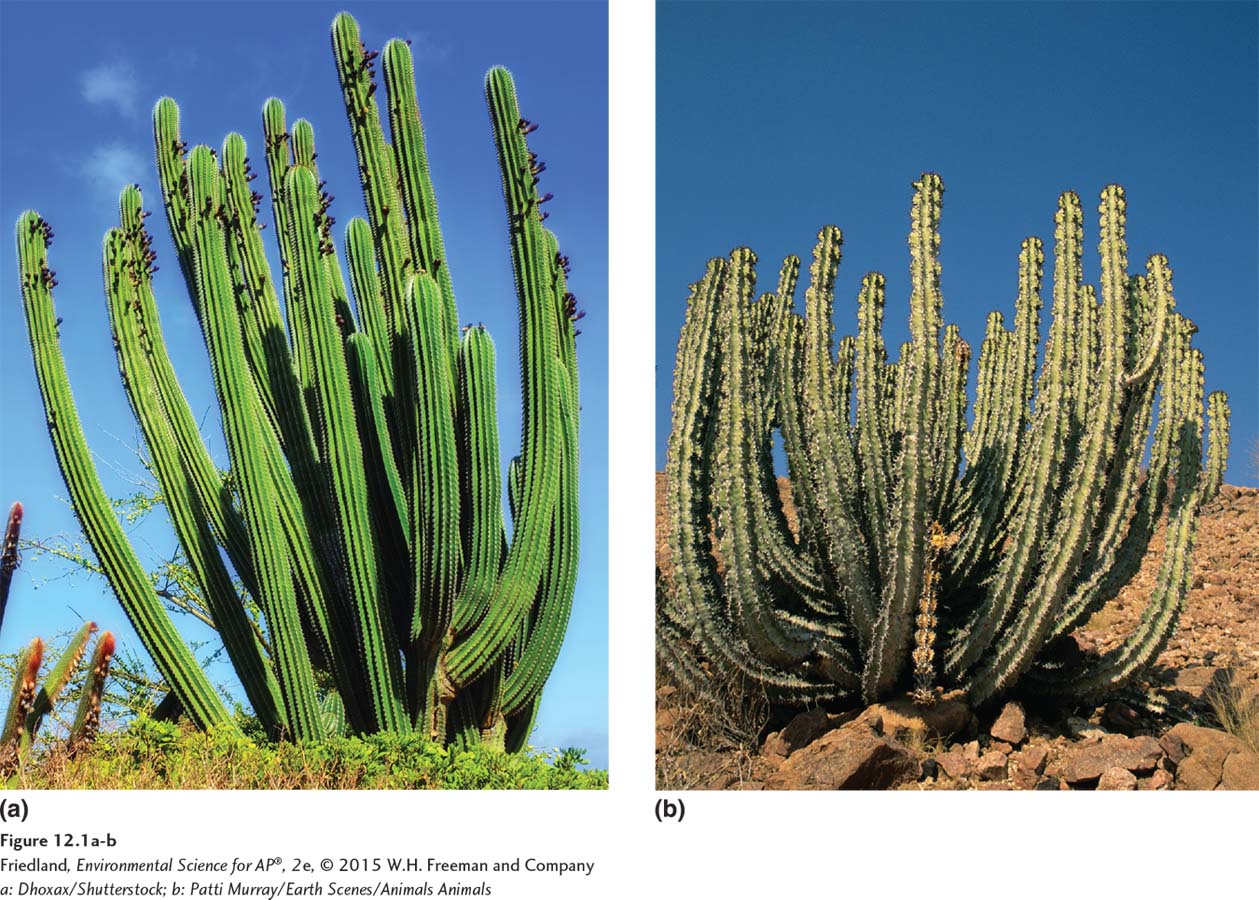
Terrestrial biome A geographic region categorized by a particular combination of average annual temperature, annual precipitation, and distinctive plant growth forms on land.
Aquatic biome An aquatic region characterized by a particular combination of salinity, depth, and water flow.
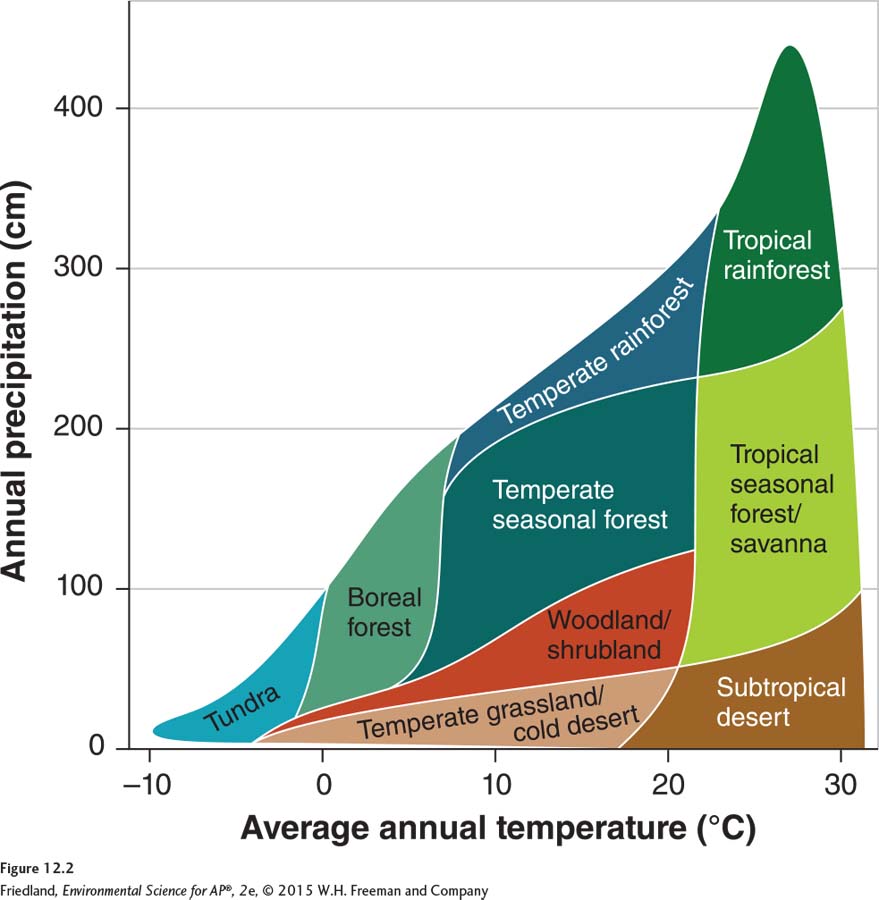
Despite these common adaptations to desert conditions, these two plant families have distinctive flowers and spines, and only the euphorb family produces a milky sap. These differences help to confirm that while the two groups may look similar, genetically they are not closely related. Instead, exposure to similar selective pressures over long periods of time favors the evolution of many similar adaptations. As a result, scientists can categorize terrestrial regions of the world into terrestrial biomes, which are geographical regions that each have a particular combination of average annual temperature and precipitation and contain distinctive plant growth forms that are adapted to that climate. In the next module we will examine aquatic biomes, which are categorized by particular combinations of salinity, depth, and water flow. FIGURE 12.2 shows the range of terrestrial biomes on Earth in the context of precipitation and temperature. For example, boreal and tundra biomes have average annual temperatures below 5°C (41°F), whereas temperate biomes have average annual temperatures between 5°C and 20°C (68°F), and tropical biomes have average annual temperatures above 20°C. Within each of these temperature ranges, we can observe a wide range of precipitation. FIGURE 12.3 shows the distribution of biomes around the world.
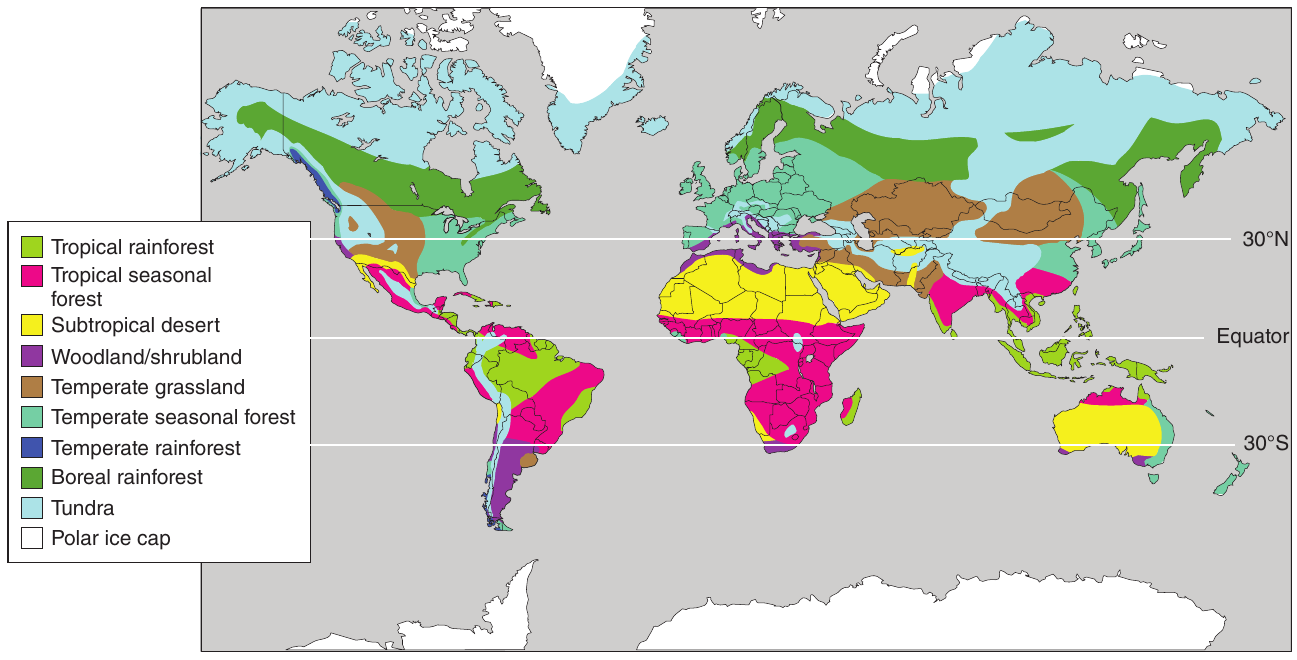
Note that although terrestrial biomes are categorized by plant growth forms, the animal species living in different biomes are often quite distinctive as well. For example, rodents inhabiting deserts around the world have a number of adaptations for hot, dry climates, including highly efficient kidneys that allow very little water loss through urination.
Climate diagrams illustrate patterns of annual temperature and precipitation
Climate diagrams, such as those shown in FIGURE 12.4, are a helpful way to visualize regional patterns of temperature and precipitation. By graphing average monthly temperature and precipitation, these diagrams illustrate how the conditions in a biome vary during a typical year. They also indicate when the temperature is warm enough for plants to grow—

In addition to the growing season, climate diagrams can show the relationship between precipitation, temperature, and plant growth. For every 10°C (18°F) temperature increase, plants need 20 mm (0.8 inches) of additional precipitation each month to supply the extra water demand that warmer temperatures cause. As a result, plant growth can be limited either by temperature or by precipitation. In FIGURE 12.4a, the precipitation line is above the temperature line during all months. This means that water supply of plants exceeds the water demand, so plant growth is more constrained by temperature than by precipitation.
In FIGURE 12.4b, we see a different scenario. When the precipitation line intersects the temperature line, the amount of precipitation available to plants equals the amount of water lost by plants through evapotranspiration. At any point where the precipitation line is below the temperature line, water demand exceeds supply. In this situation, plant growth will be constrained more by precipitation than by temperature.
Climate diagrams also help us understand how humans use different biomes. For example, areas of the world that have warm temperatures, long growing seasons, and abundant rainfall are generally highly productive and therefore are well suited to growing many crops. Warm regions that have less abundant precipitation are suitable for growing grains such as wheat and for grazing domesticated animals, including cattle and sheep. Colder regions are often best used to grow forests that will be harvested for lumber.
Terrestrial biomes range from tundra to tropical forests
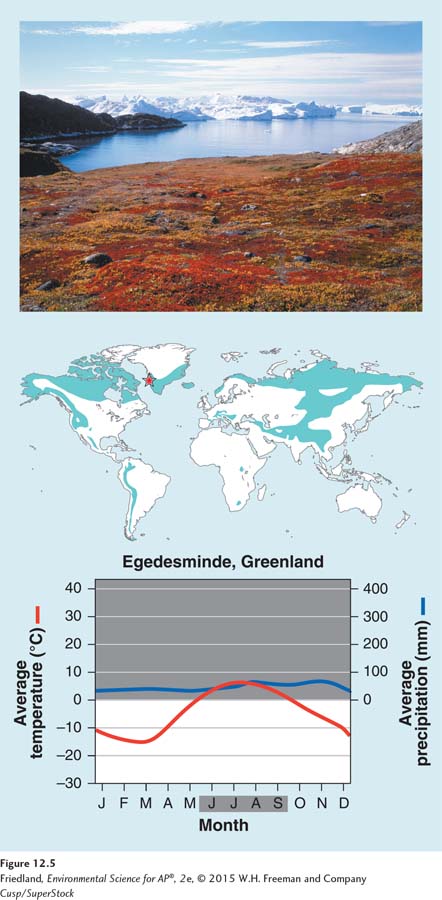
We can divide terrestrial biomes into three categories: tundra and boreal forest, temperate, and tropical. These three categories contain a total of nine biomes. We will examine each of these biomes in turn, looking at temperature and precipitation patterns, geographic distribution, and typical plant growth forms.
Tundra
Tundra A cold and treeless biome with low-
The tundra, shown in FIGURE 12.5, is a cold and treeless biome, with low-
Permafrost An impermeable, permanently frozen layer of soil.
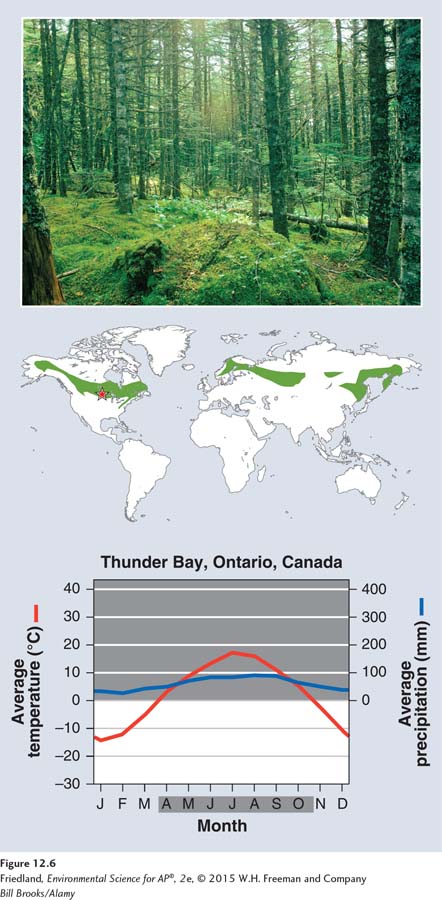
The growing season in the tundra is very short, usually only about 4 months during summer, when the polar region is tilted toward the Sun and the days are very long. During this time the upper layer of soil thaws, creating pools of standing water that are ideal habitat for mosquitoes and other insects. The underlying subsoil, known as permafrost, is an impermeable, permanently frozen layer that prevents water from draining and roots from penetrating. Permafrost, combined with the cold temperatures and a short growing season, prevents deep-
While the tundra receives little precipitation, there is enough to support some plant growth. The characteristic plants of this biome, such as small woody shrubs, mosses, heaths, and lichens, can grow in shallow, waterlogged soil and can survive short growing seasons and bitterly cold winters. At these cold temperatures, chemical reactions occur slowly, and as a result, dead plants and animals decompose slowly. This slow rate of decomposition results in the accumulation of organic matter in the soil over time with relatively low levels of soil nutrients.
Boreal Forest
Boreal forest A forest biome made up primarily of coniferous evergreen trees that can tolerate cold winters and short growing seasons.
The boreal forest biome, shown in FIGURE 12.6, consists primarily of coniferous (cone-
As in the tundra, cold temperatures and relatively low precipitation make decomposition in boreal forests a slow process. In addition, the waxy needles of evergreen trees contain compounds that are resistant to decomposition. As a result of the slow rate of decomposition and the low nutrient content of the needles, boreal forest soils are covered in a thick layer of organic material, but are poor in nutrients.
The climate characteristics of boreal forests—
Because boreal forests have poor soils and a short growing season, they are poorly suited for agriculture. However, they serve as an important source of trees for pulp, paper, and building materials. As a result, many boreal forests have been extensively logged.
Temperate Rainforest
Moving to the mid-
Temperate rainforest A coastal biome typified by moderate temperatures and high precipitation.
Moderate temperatures and high precipitation typify the temperate rainforest biome, shown in FIGURE 12.7. The temperate rainforest is a coastal biome and can be found in relatively narrow areas around the world. Temperate rainforests exist along the west coast of North America from northern California to Alaska, in southern Chile, on the east coast of Australia and in neighboring Tasmania, and on the west coast of New Zealand. Ocean currents along these coasts help to moderate temperature fluctuations, and ocean water provides a source of water vapor. The result is relatively mild summers and winters, compared with other biomes at similar latitudes, and a nearly 12-
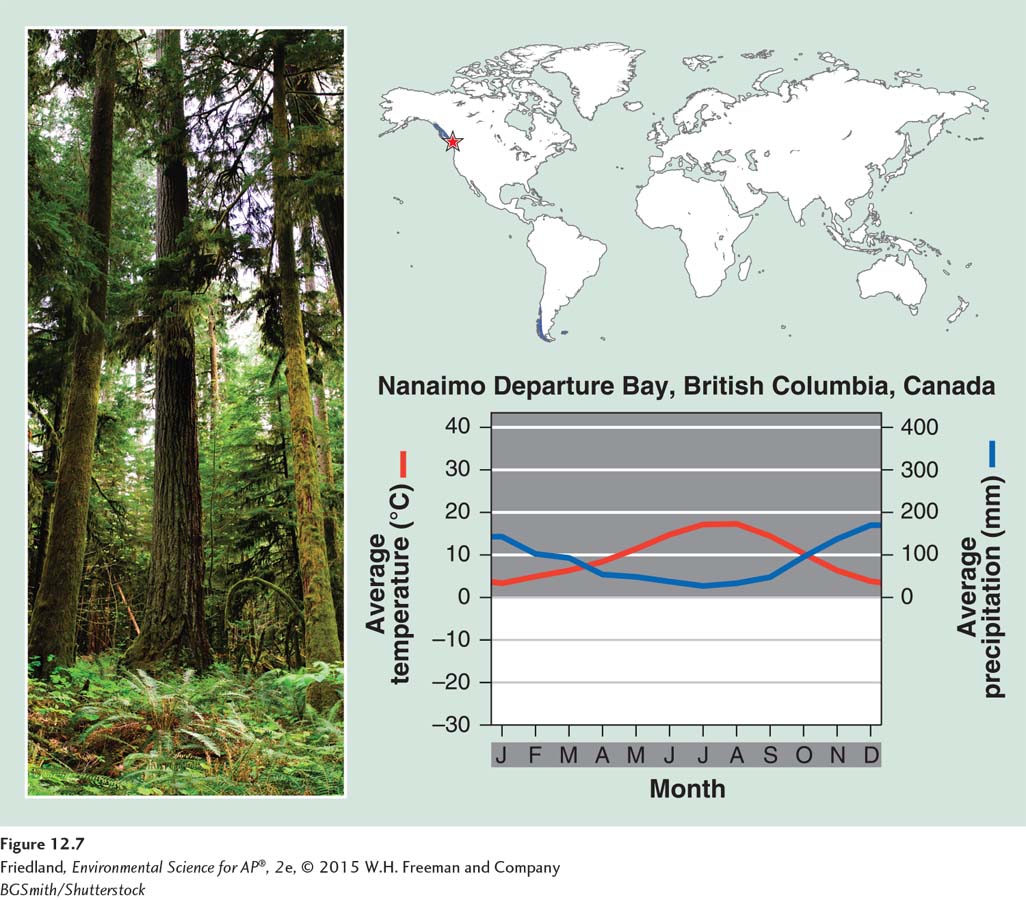
The combination of mild temperatures and high precipitation supports the growth of very large trees. In North America, the most common temperate rainforest trees are coniferous species, including fir, spruce, cedar, and hemlock as well as some of the world’s tallest trees: the coastal redwoods (Sequoia sempervirens). These immense trees can live hundreds to thousands of years and achieve heights of 90 m (295 feet) and diameters of 8 m (26 feet). Because many of these large tree species are attractive sources of lumber, much of this biome has been logged and subsequently converted into single-
As we have already seen, coniferous trees produce needles that are slow to decompose. The relatively cool temperatures in the temperate rainforest also favor slow decomposition, although it is not nearly as slow as in boreal forest and tundra. The nutrients released are rapidly taken up by the trees or leached down through the soil by the abundant rainfall, which leaves the soil low in nutrients. Ferns and mosses, which can survive in nutrient-
Temperate Seasonal Forest
Temperate seasonal forest A biome with warm summers and cold winters with over 1 m (39 inches) of precipitation annually.
The temperate seasonal forest biome, shown in FIGURE 12.8, experiences warm summers and cold winters with over 1 m (39 inches) of annual precipitation. It is found in the eastern United States, Japan, China, Europe, Chile, and eastern Australia. Away from the moderating influence of the ocean, these forests experience much warmer summers and colder winters than temperate rainforests. They are dominated by broadleaf deciduous trees such as beech, maple, oak, and hickory, although some coniferous tree species may also be present. Because of the predominance of deciduous trees, these forests are also called temperate deciduous forests.

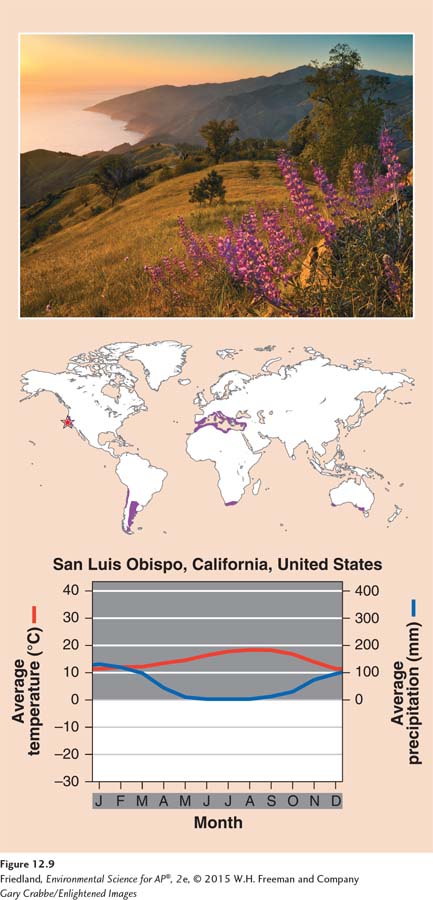
The warm summer temperatures in temperate seasonal forests favor rapid decomposition. Because the leaves shed by broadleaf trees are more readily decomposed than the needles of coniferous trees, the soils of temperate seasonal forests generally contain more nutrients than those of boreal forests. Their higher soil fertility, combined with their longer growing season, means that temperate seasonal forests have greater productivity than boreal forests.
Because the temperate seasonal forest is so productive, it has historically been one of the first biomes to be converted to agriculture on a large scale. When European settlers arrived in North America, they cleared large areas of the eastern forests for agriculture.
Woodland/Shrubland
Woodland/shrubland A biome characterized by hot, dry summers and mild, rainy winters.
The woodland/shrubland biome, illustrated in FIGURE 12.9, is characterized by hot, dry summers and mild, rainy winters. This biome is found on the coast of southern California (where it is called chaparral), in southern South America (matorral), in southwestern Australia (mallee), in southern Africa (fynbos), and in a large region surrounding the Mediterranean Sea (maquis). There is a 12-
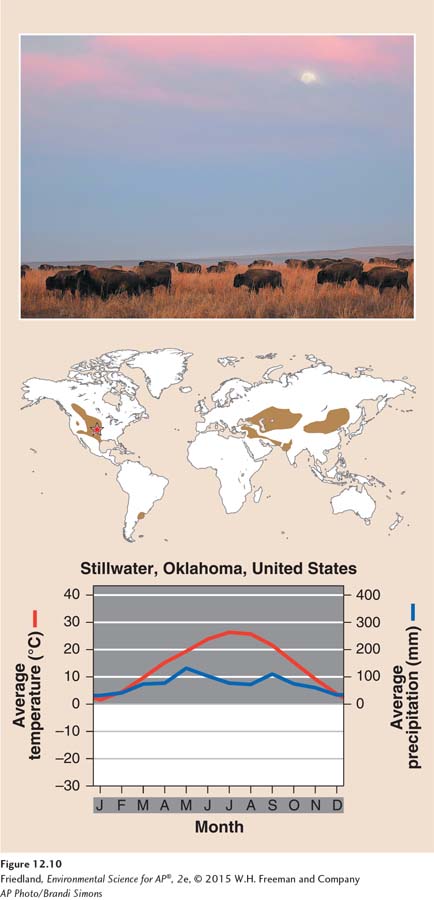
The hot, dry summers of the woodland/shrubland biome favor the natural occurrence of wildfires. Plants of this biome are well adapted to both fire and drought. Many plants quickly resprout after a fire, while others produce seeds that open only upon exposure to the intense heat of a fire. Typical plants of this biome include drought-
Temperate Grassland/Cold Desert
Temperate grassland/cold desert A biome characterized by cold, harsh winters, and hot, dry summers.
The temperate grassland/cold desert biome, shown in FIGURE 12.10, is characterized by cold, harsh winters and hot, dry summers. Temperate grasslands are found in the Great Plains of North America (where they are called prairies), in South America (pampas), and in central Asia and eastern Europe (steppes). Cold, harsh winters and hot, dry summers characterize this biome. Thus, as in the woodland/shrubland biome, plant growth is constrained by insufficient precipitation in summer and cold temperatures in winter. Fires are common, as the dry and frequently windy conditions fan flames ignited by lightning. Although estimates vary, it is thought that, historically, large wildfires occurred in this biome every few years, sometimes burning as much as 10,000 ha (nearly 25,000 acres) in a single fire.
Typical plants of temperate grasslands include grasses and nonwoody flowering plants. These plants are generally well adapted to wildfires and frequent grazing by animals. Their deep roots store energy to enable quick regrowth. Within this biome, the amount of rainfall determines which plants can survive in a region. In the North American prairies, for example, nearly 1 m (39 inches) of rain falls per year on the eastern edge of the biome, supporting grasses that can grow up to 2.5 m (8 feet) high. Although these tallgrass prairies receive sufficient rainfall for trees to grow, frequent wildfires keep trees from encroaching. In fact, the Native American people are thought to have intentionally kept the eastern prairies free of trees by using controlled burning. To the west, annual precipitation drops to 0.5 m (20 inches), favoring the growth of grasses less than 0.5 m (20 inches) tall. These shortgrass prairies are simply too dry to support trees or tall grasses. Farther west, in the rain shadow of the Rocky Mountains, annual precipitation continues to decline to 0.25 m (10 inches). In this region, the short-

Cold deserts, also known as temperate deserts, have even sparser vegetation than shortgrass prairies. Cold deserts are distinct from subtropical deserts in that they have much colder winters and do not support the characteristic plant growth forms of hot deserts, such as cacti and euphorbs.
The combination of a relatively long growing season and rapid decomposition that adds large amounts of nutrients to the soil makes temperate grasslands very productive. More than 98 percent of the tallgrass prairie in the United States has been converted to agriculture, while the less productive shortgrass prairie is predominantly used for growing wheat and grazing cattle.
Tropical Rainforest
In the tropics, average annual temperatures exceed 20°C. Here we find the tropical biomes: tropical rainforests, tropical seasonal forests/savannas, and subtropical deserts.
Tropical rainforest A warm and wet biome found between 20° N and 20° S of the equator, with little seasonal temperature variation and high precipitation.
The tropical rainforest biome, shown in FIGURE 12.11, is a warm and wet biome that lies within approximately 20° N and 20° S of the equator. This biome is found in Central and South America, Africa, Southeast Asia, and northeastern Australia. It is also found on large tropical islands, where the oceans provide a constant source of atmospheric water vapor.
The tropical rainforest biome is warm and wet, with little seasonal temperature variation. Precipitation occurs frequently, although there are seasonal patterns in precipitation that depend on when the ITCZ passes overhead. Because of the warm temperatures and abundant rainfall, productivity is high, and decomposition is extremely rapid. The lush vegetation takes up nutrients quickly, leaving few nutrients to accumulate in the soil. Because of its high productivity, approximately 24,000 ha (59,500 acres) of tropical rainforest are cleared each year for agriculture. However, the high rate of decomposition causes the soils to lose their fertility quickly. As a result, farmers growing crops on tropical soils often have to keep moving to newly deforested areas.
Tropical rainforests contain more biodiversity per hectare than any other terrestrial biome. As much as two-
Tropical Seasonal Forest/Savanna
Tropical seasonal forest/savanna A biome marked by warm temperatures and distinct wet and dry seasons.
The tropical seasonal forests/savanna biome, shown in FIGURE 12.12, is marked by warm temperatures and distinct wet and dry seasons. This seasonal pattern is caused by the seasonal movement of the ITCZ, which, because it tracks the seasonal movement of the most intense sunlight, passes overhead and drops precipitation only during summer. The trees drop their leaves during the dry season as an adaptation to survive the drought conditions and produce new leaves during the wet season. Thus these forests are also called tropical deciduous forests.

Tropical seasonal forests are common in much of Central America, on the Atlantic coast of South America, in southern Asia, in northwestern Australia, and in sub-
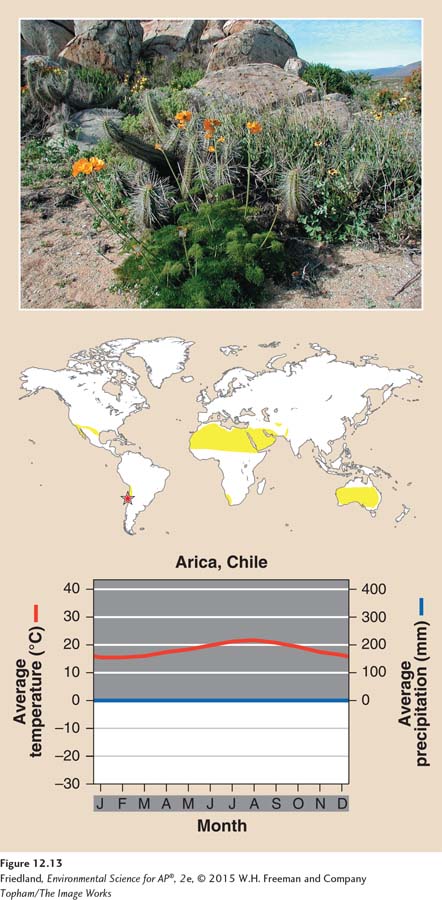
The warm temperatures of the tropical seasonal forest/savanna biome promote decomposition, but the low amounts of precipitation constrain plants from using the soil nutrients that are released. As a result, the soils of this biome are fairly fertile and can be farmed. Their fertility has resulted in the conversion of large areas of tropical seasonal forest and savanna into agricultural fields and grazing lands. For example, over 99 percent of the tropical seasonal forest of Pacific Central America and the Atlantic coast of South America has been converted to human uses, including agriculture and grazing.
Subtropical Desert
Subtropical desert A biome prevailing at approximately 30° N and 30° S, with hot temperatures, extremely dry conditions, and sparse vegetation.
The subtropical desert biome, shown in FIGURE 12.13, is located at roughly 30° N and 30° S, and is characterized by hot temperatures, extremely dry conditions, and sparse vegetation. Also known as hot deserts, this biome includes the Mojave Desert in the southwestern United States, the Sahara Desert in Africa, the Arabian Desert of the Middle East, and the Great Victoria Desert of Australia. Cacti, euphorbs, and succulent plants are well adapted to this biome. To prevent water loss, the leaves of desert plants may be small, nonexistent, or modified into spines, and the outer layer of the plant is thick, with few pores for water and air exchange. Most photosynthesis occurs along the plant stem, which stores water so that photosynthesis can continue even during very dry periods. To protect themselves from herbivores, desert plants have developed defense mechanisms such as spines to discourage grazing.
When rain does fall, the desert landscape is transformed. Annual plants—